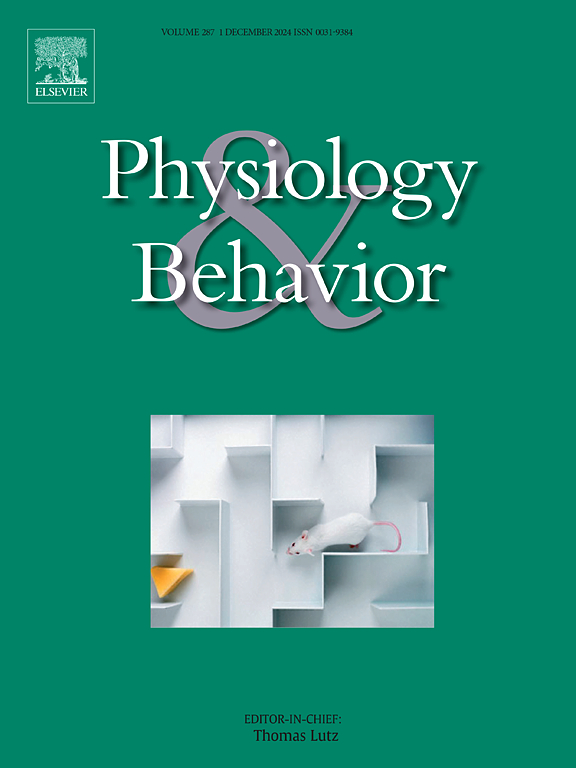成年Wistar大鼠慢性青春期应激减弱吗啡诱导的抗痛觉和中央杏仁核神经元激活。
IF 2.5
3区 医学
Q2 BEHAVIORAL SCIENCES
引用次数: 0
摘要
在发育关键期的压力暴露已被证明会增加成年后一系列心理和生理疾病的风险,包括物质使用障碍和慢性疼痛。虽然不完全理解,但研究表明,压力改变阿片反应,这反过来又与伤害性反应增加和抗伤害性反应减少有关。先前的研究表明,吗啡抗痛觉的应激诱导衰减使用应激暴露模型,包括身体损伤,限制了现有研究结果的推广。当前研究的目的是表征慢性青少年心理社会压力对吗啡诱导的抗痛觉和神经元激活的影响。雄性和雌性Wistar大鼠暴露于慢性青春期应激(CAS),并在成年后测试吗啡或吗啡诱导的杏仁核中央核(CeA)和腹外侧导水管周围灰质(vlPAG) cFos表达的抗伤害性反应。在两性温水断尾试验中,CAS减轻吗啡诱导的抗痛觉反应的历史,证明了青春期应激对成年期阿片类药物反应的影响,不分性别。同样,CAS病史对吗啡诱导的cFos在CeA中的表达反应迟钝,但对两性的vlPAG没有反应迟钝。总的来说,这些数据表明,CAS暴露使阿片类镇痛药的效果降低,这种改变与CeA中阿片类药物的反应性改变有关。进一步的工作确定介导应激引起的阿片信号变化的机制是必要的,有可能影响有发育应激史的个体的疼痛管理策略。本文章由计算机程序翻译,如有差异,请以英文原文为准。
Chronic adolescent stress attenuates morphine-induced antinociception and central amygdala neuronal activation in adult Wistar rats
Stress exposure during critical developmental periods has been shown to increase the risk for an array of psychological and physiological pathologies in adulthood, including substance use disorder and chronic pain. Although incompletely understood, studies have suggested that stress alters opioid responses which in turn is associated with increased nociceptive and decreased antinociceptive responsivity. Previous studies demonstrating stress-induced attenuation of morphine antinociception used stress exposure models that included physical injury limiting generalization of the available findings. The aim of the current study was to characterize the effects of chronic adolescent psychosocial stress on morphine-induced antinociception and neuronal activation. Male and female Wistar rats were exposed to chronic adolescent stress (CAS) and tested in adulthood for either antinociceptive response to morphine or morphine-induced expression of cFos in the central nucleus of the amygdala (CeA) and ventrolateral periaqueductal gray (vlPAG). A history of CAS attenuated morphine-induced antinociception in the warm water tail withdrawal test for both sexes, demonstrating an effect of adolescent stress on responses to opioids in adulthood, regardless of sex. Similarly, CAS history caused a blunted response to morphine-induced cFos expression in the CeA, but not in the vlPAG for both sexes. Collectively, these data suggest that CAS exposure renders opioid analgesics less effective, and that this alteration is associated with altered responsivity to opioids in the CeA. Additional work identifying the mechanisms mediating stress-induced changes in opioid signaling are warranted, having the potential to influence pain management strategies for individuals with developmental stress histories.
求助全文
通过发布文献求助,成功后即可免费获取论文全文。
去求助
来源期刊

Physiology & Behavior
医学-行为科学
CiteScore
5.70
自引率
3.40%
发文量
274
审稿时长
47 days
期刊介绍:
Physiology & Behavior is aimed at the causal physiological mechanisms of behavior and its modulation by environmental factors. The journal invites original reports in the broad area of behavioral and cognitive neuroscience, in which at least one variable is physiological and the primary emphasis and theoretical context are behavioral. The range of subjects includes behavioral neuroendocrinology, psychoneuroimmunology, learning and memory, ingestion, social behavior, and studies related to the mechanisms of psychopathology. Contemporary reviews and theoretical articles are welcomed and the Editors invite such proposals from interested authors.
 求助内容:
求助内容: 应助结果提醒方式:
应助结果提醒方式:


